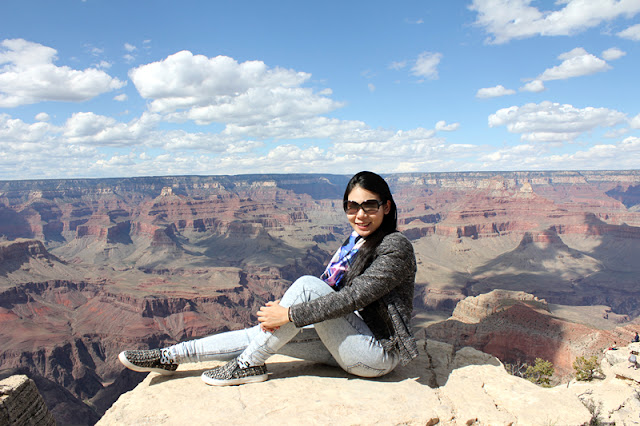The journey continues with a scenic drive through the shrubs and cotton candy clouds in Arizona. Perfect mood-lifting weather and a beautiful scenery already made my day.
FINALLY, arriving at Grand Canyon National Park!
About 10 minutes drive to the Visitor Center where we parked the car.

It is convenient getting around with the free shuttle buses around Grand Canyon. There are several coloured buses each with different routes to parts of the Southern Rim Trail. Because of time constraint, we could only afford to go one of the view points - Mather Point.
Mather Point lookout, with magnificent and breathtaking views! The shadows cast by the clouds and neighbouring cliffs giving the Grand Canyon a different view at different times of the day. Grand Canyon is known for its visually overwhelming size and its intricate and colorful landscape. Geologically it is significant because of the thick sequence of ancient rocks that are beautifully preserved and exposed in the walls of the canyon. These rock layers record much of the early geologic history of the North American continent.
History and Formation of the Grand Canyon (Wikipedia)
The major geologic exposures in the Grand Canyon range in age from the 2-billion-year-old Vishnu Schist at the bottom of the Inner Gorge to the 230M-year-old Khaibab Limestone on the Rim. There is a gap of about a billion years between the 500M-year-old stratum and the level below it, which dates to about 1.5 billion years ago. This large unconfomity indicates a period of erosion between two periods of deposition.
The great depth of the Grand Canyon and especially the height of its strata can be attributed to1,500 to 3,000 m of uplift of the Colorado Plateau, starting about 65M years ago. This uplift has steepened the stream gradient of the Colorado River and its tributaries, which in turn has increased their speed and thus their ability to cut through rock
Weather conditions during the ice ages also increased the amount of water in the Colorado River drainage system. The ancestral Colorado River responded by cutting its channel faster and deeper.
The base level and course of the Colorado River changed 5.3M years ago when the Gulf of California opened and lowered the river's base level. This increased the rate of erosion and cut nearly all of the Grand Canyon's current depth by 1.2M years ago. The terraced walls of the canyon were created by differential erosion.
Between 100,000 and 3M years ago, volcanic activity deposited ash and lava over the area which at times completely obstructed the river. These volcanic rocks are the youngest in the canyon.
Another 9 hours drive back home with panoramic sunset views along the way.



























Post a Comment